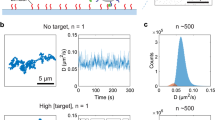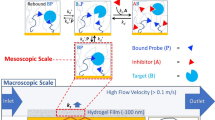Abstract
We have developed a rapid diffusion immunoassay that allows measurement of small molecules down to subnanomolar concentrations in <1 min. This competitive assay is based on measuring the distribution of a labeled probe molecule after it diffuses for a short time from one region into another region containing antigen-specific antibodies. The assay was demonstrated in the T-sensor, a simple microfluidic device that places two fluid streams in contact and allows interdiffusion of their components. The model analyte was phenytoin, a typical small drug molecule. Clinically relevant levels were measured in blood diluted from 10- to 400-fold in buffer containing the labeled antigen. Removal of cells from blood samples was not necessary. This assay compared favorably with fluorescence polarization immunoassay (FPIA) measurements. Numerical simulations agree well with experimental results and provide insight for predicting assay performance and limitations. The assay is homogeneous, requires <1 μl of reagents and sample, and is applicable to a wide range of analytes.
This is a preview of subscription content, access via your institution
Access options
Subscribe to this journal
Receive 12 print issues and online access
$209.00 per year
only $17.42 per issue
Buy this article
- Purchase on Springer Link
- Instant access to full article PDF
Prices may be subject to local taxes which are calculated during checkout





Similar content being viewed by others
References
Kricka, L.J. Miniaturization of analytical systems. Clin. Chem. 44, 2008–2014 (1998).
Regnier, F.E., He, B., Lin, S. & Busse, J. Chromatography and electrophoresis on chips: critical elements of future integrated, microfluidic analytical systems for life science. Trends Biotechnol. 17, 101–106 (1999).
Kopp, M.U., Mello, A.J. & Manz, A. Chemical amplification: continuous-flow PCR on a chip. Science 280, 1046–1048 (1998).
Schmalzing, D. et al. DNA typing in thirty seconds with a microfabricated device. Proc. Natl. Acad. Sci. USA 94, 10273–10278 (1997).
Fu, A.Y., Spence, C., Scherer, A., Arnold, F.H. & Quake, S.R. A microfabricated fluorescence-activated cell sorter. Nat. Biotechnol. 17, 1109–1111 (1999).
Ekins, R. Immunoassay: recent developments and future directions. Nucl. Med. Biol. 21, 495–521 (1994).
Brown, E.N., McDermott, T.J., Bloch, K.J. & McCollom, A.D. Defining the smallest analyte concentration an immunoassay can measure. Clin. Chem. 42, 893–903 (1996).
Hicks, J.M. Fluorescence immunoassay. Hum. Pathol. 15, 112–116 (1984).
Sherry, J. Environmental immunoassays and other bioanalytical methods: overview and update. Chemosphere 34, 1011–1025 (1997).
Chan, D.W. Clinical instrumentation (immunoassay analyzers). Anal. Chem. 67, R519–R524 (1995).
Chiem, N.H. & Harrison, D.J. Microchip systems for immunoassay: an integrated immunoreactor with electrophoretic separation for serum theophylline determination. Clin. Chem. 44, 591–598 (1998).
Schmalzing, D. & Nashabeh, W. Capillary electrophoresis based immunoassays: a critical review. Electrophoresis 18, 2184–2193 (1997).
Weigl, B.H. & Yager, P. Microfluidic diffusion-based separation and detection. Science 283, 346–347 (1999).
Kamholz, A.E., Weigl, B.H., Finlayson, B.A. & Yager, P. Quantitative analysis of molecular interaction in a microfluidic channel: The T-Sensor. Anal. Chem. 71, 5340–5347 (1999).
Kamholz, A.E. & Yager, P. Theoretical analysis of molecular diffusion in pressure-driven flow in microfluidic channels. Biophys. J. 80, 155–160 (2001).
Paxton, J.W., Rowell, F.J. & Ratcliffe, J.G. Production and characterisation of antisera to diphenylhydantoin suitable for radioimmunoassay. J. Immunol. Methods 10, 317–327 (1976).
McGregor, A.R., Crookall-Greening, J.O., Landon, J. & Smith, D.S. Polarisation fluoroimmunoassay of phenytoin. Clin. Chim. Acta 83, 161–166 (1978).
Jolley, M.E. Fluorescence polarization immunoassay for the determination of therapeutic drug levels in human plasma. J. Anal. Toxicol. 5, 236–240 (1981).
Montgomery, M.R., Holtzman, J.L., Leute, R.K., Dewees, J.S. & Bolz, G. Determination of diphenylhydantoin in human serum by spin immunoassay. Clin. Chem. 21, 221–226 (1975).
Booker, H.E. & Darcey, B.A. Enzymatic immunoassay vs. gas/liquid chromatography for determination of phenobarbital and diphenylhydantoin in serum. Clin. Chem. 21, 1766–1768 (1975).
Peters, T. Jr. All about albumin: biochemistry, genetics, and medical applications. (Academic Press, Inc., San Diego, CA; 1996).
Anon. Data reduction of enzyme-immunoassay by log-logit curve. Lab. Med. 22, 877–879 (1991).
Kamholz, A.E., Schilling, E.A. & Yager, P. Optical measurement of transverse molecular diffusion in a microchannel. Biophys. J. 80, 1967–1972 (2001).
Maciel, R.J. Standard curve fitting in immunodiagnostics: a primer. J. Clin. Immunoassay 8, 98–106 (1985).
Fylstra, D., Lasdon, L., Watson, J. & Waren, A. Design and use of Microsoft Excel Solver. Interfaces 28, 29–55 (1998).
Griffiths, A.D. et al. Human anti-self antibodies with high specificity from phage display libraries. EMBO J. 12, 725–734 (1993).
Acknowledgements
This work was supported by Micronics Inc., the Washington Technology Center, and DARPA MicroFlumes program contract no. N660001-97-C-8632. We would like to thank Dr. Mark Holl for the majority of the design and implementation of the flow cell and fluidics system, Cathy Cabrera for developing image analysis software, Dr. Alex Goldstein for characterization of chemicals useful for pretreating blood samples, and Dr. Shelli R. Dennis for assistance exploring data analysis software. We thank Dr. Margaret Kenny, Diane Zebert, and Dr. Cai Cai Wu for work leading to immunoassay development in the T-sensor. Paul Yager has a financial interest in Micronics, Inc.
Author information
Authors and Affiliations
Corresponding author
Rights and permissions
About this article
Cite this article
Hatch, A., Kamholz, A., Hawkins, K. et al. A rapid diffusion immunoassay in a T-sensor. Nat Biotechnol 19, 461–465 (2001). https://doi.org/10.1038/88135
Received:
Accepted:
Issue Date:
DOI: https://doi.org/10.1038/88135
This article is cited by
-
Analysis of interfacial mixing zone and mixing index in microfluidic channels
Microfluidics and Nanofluidics (2023)
-
On the utility of microfluidic systems to study protein interactions: advantages, challenges, and applications
European Biophysics Journal (2023)
-
Microfluidic approaches for the analysis of protein–protein interactions in solution
Biophysical Reviews (2020)
-
A successive laminar flow extraction for plant medicine preparation by microfluidic chip
Microfluidics and Nanofluidics (2019)
-
Monitoring microbial metabolites using an inductively coupled resonance circuit
Scientific Reports (2015)



